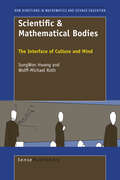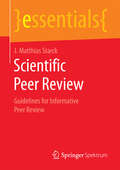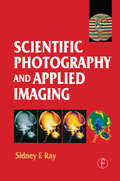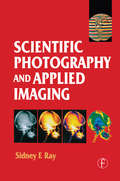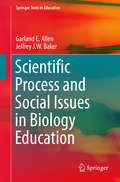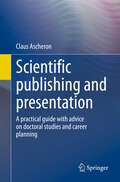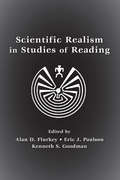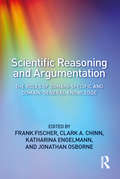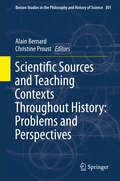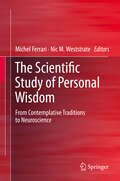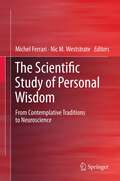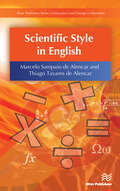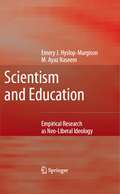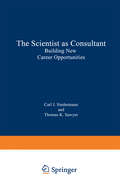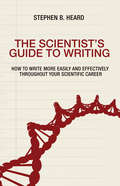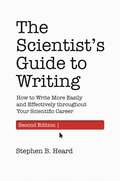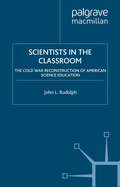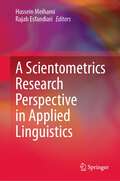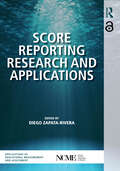- Table View
- List View
Scientific & Mathematical Bodies: The Interface of Culture and Mind (New Directions in Mathematics and Science Education #22)
by SungWon Hwang Wolff-Michael RothThis book is about the sensuous, living body without which individual knowing and learning is impossible. It is the interface between the individual and culture. Recent scholarship has moved from investigated knowing and learning as something in the mind or brain to understanding these phenomena in terms of the body (embodiment literature) or culture (social constructivism). These two literatures have expanded the understanding of cognition to include the role of the body in shaping the mind and to recognize the tight relation between mind and culture. However, there are numerous problems arising from ways in which the body and culture are thought in these separate research domains. In this book, the authors present an interdisciplinary, scientific initiative that brings together the concerns for body and for culture to develop a single theory of cognition centered on the living and lived body. This book thereby contributes to bridging the gap that currently exists between theory (knowing that) and praxis (knowing how) that is apparent in the existing science and mathematics education literatures.
Scientific Peer Review: Guidelines for Informative Peer Review (essentials)
by J. Matthias StarckJ. Matthias Starck comprehensively guides the reader in this essential through all steps of writing an expert review for a scientific journal. It is built on a succinct analysis how science works, how science is communicated and how science is published. It provides a critical guide how to write good, informative and fair peer reviews. The author presents a critical discussion of different peer review procedures and their alternatives, explains ethical guidelines as well as the dark sides of scientific publishing. So this essential helps the reader to perform better in the existing system and to contribute to its further development and improvement.
Scientific Photography and Applied Imaging
by Sidney RayWINNER OF THE 2001 KRASZNA-KRAUSZ PHOTOGRAPHY BOOK AWARD (Technical Photography category)The only definitive book to fully encompass the use of photography and imaging as tools in science, technology and medicine. It describes in one single volume the basic theory, techniques, materials, special equipment and applications for a wide variety of uses of photography, including: close up photography and photomacrography to spectral recording, surveillance systems, radiography and micro-imaging. This extensively illustrated photography 'bible' contains all the information you need, whether you are a scientist wishing to use photography for a specialist application, a professional needing to extend technical expertise, or a student wanting to broaden your knowledge of the applications of photography.The contents are arranged in three sections:· General Section, detailing the elements of the image capture process· Major Applications, describing the major applications of imaging · Specialist Applications, presenting an eclectic selection of more specialised but increasingly important applicationsEach subject is introduced with an outline of its development and contemporary importance, followed by explanations of essential theory and an overview of techniques and equipment. Mathematics is only used where necessary. Numerous applications and case studies are described. Comprehensive bibliographies and references are provided for further study.
Scientific Photography and Applied Imaging
by Sidney RayWINNER OF THE 2001 KRASZNA-KRAUSZ PHOTOGRAPHY BOOK AWARD (Technical Photography category)The only definitive book to fully encompass the use of photography and imaging as tools in science, technology and medicine. It describes in one single volume the basic theory, techniques, materials, special equipment and applications for a wide variety of uses of photography, including: close up photography and photomacrography to spectral recording, surveillance systems, radiography and micro-imaging. This extensively illustrated photography 'bible' contains all the information you need, whether you are a scientist wishing to use photography for a specialist application, a professional needing to extend technical expertise, or a student wanting to broaden your knowledge of the applications of photography.The contents are arranged in three sections:· General Section, detailing the elements of the image capture process· Major Applications, describing the major applications of imaging · Specialist Applications, presenting an eclectic selection of more specialised but increasingly important applicationsEach subject is introduced with an outline of its development and contemporary importance, followed by explanations of essential theory and an overview of techniques and equipment. Mathematics is only used where necessary. Numerous applications and case studies are described. Comprehensive bibliographies and references are provided for further study.
Scientific Process and Social Issues in Biology Education (Springer Texts in Education)
by Garland E. Allen Jeffrey J.W. BakerThis book complements fact-drive textbooks in introductory biology courses, or courses in biology and society, by focusing on several important points: (1) Biology as a process of doing science, emphasizing how we know what we know. (2) It stresses the role of science as a social as well as intellectual process, one that is always embedded in its time and place in history.In dealing with the issue of science as a process, the book introduces students to the elements of inductive and deductive logic, hypothesis formulation and testing, the design of experiments and the interpretation of data. An appendix presents the basics of statistical analysis for students with no background in statistical reasoning and manipulation. Reasoning processes are always illustrated with specific examples from both the past (eighteenth and nineteenth century) as well as the present.In dealing with science and social issues, this book introduces students to historical, sociological and philosophical issues such as Thomas Kuhn’s concept of paradigms and paradigm shifts, the social-constructions view of the history of science, as well as political and ethical issues such human experimentation, the eugenics movement and compulsory sterilization, and religious arguments against stem cell research and the teaching of evolution in schools.In addition to specific examples illustrating one point or another about the process of biology or social-political context, a number of in-depth case studies are used to show how scientific investigations are originated, designed, carried out in particular social/cultural contexts. Among those included are: Migration of monarch butterflies, John Snow’s investigations on the cause of cholera, Louis Pasteur’s controversy over spontaneous generation, the mass extinction of the dinosaurs, and the Tuskegee syphilis experiment.
Scientific publishing and presentation: A practical guide with advice on doctoral studies and career planning
by Claus AscheronThe aim of this book is to help young scientists improve their oral and written communication skills and thus better sell their own results. This book is not a scientific textbook. It addresses the often forgotten question of how to present one's scientific results effectively and convincingly in talks and publications. In addition, this book provides background knowledge on the process of scientific publishing and scientific customs. The recommendations help to develop a good and effective work and communication style that will benefit you throughout your life and bring satisfaction in your work. Furthermore, concrete advice is given on how to write and successfully defend a dissertation and how to take the first steps in career planning.
Scientific Realism in Studies of Reading
by Alan D. Flurkey, Eric J. Paulson and Kenneth S. GoodmanThis book provides research-based insights that deepen and broaden current understandings of the nature of reading. Informed by psycholinguistic and sociolinguistic views of reading-as-meaning-construction, the studies build on principles of scientific realism – an approach to inquiry that incorporates and values a wide variety of methods of observation to find the most inclusive, ecologically valid description of the reading process as it is observed in a variety of contexts from a wide range of perspectives. Focusing on how facts are discovered, developed, and used in the construction of knowledge about reading – a data-driven and theory-driven construction that results from observing the reading process with a variety of tools, methods, disciplines, and conceptual frameworks – scientific realism goes beyond rationalism and experimentation to include studies of events and experiences, but still satisfies even the most narrow definitions of what state and national lawmakers refer to as "reliable and replicable research on reading." Each study in this volume breaks ground for a new line of reading research underpinned by the theory of reading based in scientific realism. Scientific Realism in Studies of Reading is directed to reading researchers, teacher educators, reading specialists, special educators, graduate students, and related education professionals in the disciplines of applied psycholinguistics and sociolinguistics, and is appropriate as a text for advanced courses in these areas.
Scientific Realism in Studies of Reading
This book provides research-based insights that deepen and broaden current understandings of the nature of reading. Informed by psycholinguistic and sociolinguistic views of reading-as-meaning-construction, the studies build on principles of scientific realism – an approach to inquiry that incorporates and values a wide variety of methods of observation to find the most inclusive, ecologically valid description of the reading process as it is observed in a variety of contexts from a wide range of perspectives. Focusing on how facts are discovered, developed, and used in the construction of knowledge about reading – a data-driven and theory-driven construction that results from observing the reading process with a variety of tools, methods, disciplines, and conceptual frameworks – scientific realism goes beyond rationalism and experimentation to include studies of events and experiences, but still satisfies even the most narrow definitions of what state and national lawmakers refer to as "reliable and replicable research on reading." Each study in this volume breaks ground for a new line of reading research underpinned by the theory of reading based in scientific realism. Scientific Realism in Studies of Reading is directed to reading researchers, teacher educators, reading specialists, special educators, graduate students, and related education professionals in the disciplines of applied psycholinguistics and sociolinguistics, and is appropriate as a text for advanced courses in these areas.
Scientific Reasoning and Argumentation: The Roles of Domain-Specific and Domain-General Knowledge
by Frank Fischer Clark A. Chinn Katharina Engelmann Jonathan OsborneCompetence in scientific reasoning is one of the most valued outcomes of secondary and higher education. However, there is a need for a deeper understanding of and further research into the roles of domain-general and domain-specific knowledge in such reasoning. This book explores the functions and limitations of domain-general conceptions of reasoning and argumentation, the substantial differences that exist between the disciplines, and the role of domain-specific knowledge and epistemologies. Featuring chapters and commentaries by widely cited experts in the learning sciences, educational psychology, science education, history education, and cognitive science, Scientific Reasoning and Argumentation presents new perspectives on a decades-long debate about the role of domain-specific knowledge and its contribution to the development of more general reasoning abilities.
Scientific Reasoning and Argumentation: The Roles of Domain-Specific and Domain-General Knowledge
by Frank Fischer Clark A. Chinn Katharina Engelmann Jonathan OsborneCompetence in scientific reasoning is one of the most valued outcomes of secondary and higher education. However, there is a need for a deeper understanding of and further research into the roles of domain-general and domain-specific knowledge in such reasoning. This book explores the functions and limitations of domain-general conceptions of reasoning and argumentation, the substantial differences that exist between the disciplines, and the role of domain-specific knowledge and epistemologies. Featuring chapters and commentaries by widely cited experts in the learning sciences, educational psychology, science education, history education, and cognitive science, Scientific Reasoning and Argumentation presents new perspectives on a decades-long debate about the role of domain-specific knowledge and its contribution to the development of more general reasoning abilities.
Scientific Sources and Teaching Contexts Throughout History: Problems And Perspectives (Boston Studies in the Philosophy and History of Science #301)
by Alain Bernard Christine ProustThis book examines the textual, social, cultural, practical and institutional environments to which the expression “teaching and learning contexts” refers. It reflects on the extent to which studying such environments helps us to better understand ancient or modern sources, and how notions of “teaching” and “learning” are to be understood.Tackling two problems: the first, is that of certain sources of scientific knowledge being studied without taking into account the various “contexts” of transmission that gave this knowledge a long-lasting meaning. The second is that other sources are related to teaching and learning activities, but without being too precise and demonstrative about the existence and nature of this “teaching context”. In other words, this book makes clear what is meant by “context” and highlights the complexity of the practice hidden by the words “teaching” and “learning”. Divided into three parts, the book makes accessible teaching and learning situations, presents comparatist approaches, and emphasizes the notion of teaching as projects embedded in coherent treatises or productions.
The Scientific Study of Personal Wisdom: From Contemplative Traditions to Neuroscience
by Michel Ferrari and Nic M. WeststrateThe rich and diverse contributions to this volume span a wide variety of disciplines, from psychology and philosophy to neuroscience, by some of the most influential scholars in the emerging science of personal wisdom. As such, it is a collection of essential readings and the first publication to integrate both the spiritual and pragmatic dimensions of personal wisdom.The content of the book goes beyond speculative theory to present a wealth of scientific research currently under way in this expanding field. It also describes numerous promising methods now being deployed in the quest for scientific knowledge of the elusive, yet critical, phenomenon of personal wisdom. The book is an excellent introduction to the field for novice researchers as well as a stimulating and enlightening resource for established experts. Its broad appeal makes it a vital addition to the libraries of academics and practitioners in many disciplines, from developmental psychology to gerontology and from philosophy to contemplative religious traditions such as Buddhism.
The Scientific Study of Personal Wisdom: From Contemplative Traditions to Neuroscience
by Michel Ferrari and Nicholas WeststrateThe rich and diverse contributions to this volume span a wide variety of disciplines, from psychology and philosophy to neuroscience, by some of the most influential scholars in the emerging science of personal wisdom. As such, it is a collection of essential readings and the first publication to integrate both the spiritual and pragmatic dimensions of personal wisdom.The content of the book goes beyond speculative theory to present a wealth of scientific research currently under way in this expanding field. It also describes numerous promising methods now being deployed in the quest for scientific knowledge of the elusive, yet critical, phenomenon of personal wisdom. The book is an excellent introduction to the field for novice researchers as well as a stimulating and enlightening resource for established experts. Its broad appeal makes it a vital addition to the libraries of academics and practitioners in many disciplines, from developmental psychology to gerontology, and from philosophy to contemplative religious traditions such as Buddhism.
Scientific Style in English
by Marcelo Sampaio Alencar Thiago Tavares AlencarStyle is a distinctive manner of expression, in writing or speech. The wordevolved from Latin stilus, an instrument for writing, marking, or incising,such as something used by the ancients in writing on clay or waxed tablets.It is the way in which something is said or done, as distinguished fromits substance. Style is also a convention with respect to spelling, punctuation,capitalization, and typographic arrangement and display followed in writingor printing.Scientific Style in English aims to help students with the reading and writing of scientific and technical texts in English, with a particular focus on style, grammar and math. It can be used by students and professionals with basic or intermediate understanding of theEnglish language.Technical topics discussed in the book include: Scientific Style in English Mathematical Style in English Technical Style Stylistic Problems in English How to write Theses and Dissertations
Scientific Style in English
by Marcelo Sampaio Alencar Thiago Tavares AlencarStyle is a distinctive manner of expression, in writing or speech. The wordevolved from Latin stilus, an instrument for writing, marking, or incising,such as something used by the ancients in writing on clay or waxed tablets.It is the way in which something is said or done, as distinguished fromits substance. Style is also a convention with respect to spelling, punctuation,capitalization, and typographic arrangement and display followed in writingor printing.Scientific Style in English aims to help students with the reading and writing of scientific and technical texts in English, with a particular focus on style, grammar and math. It can be used by students and professionals with basic or intermediate understanding of theEnglish language.Technical topics discussed in the book include: Scientific Style in English Mathematical Style in English Technical Style Stylistic Problems in English How to write Theses and Dissertations
Scientism and Education: Empirical Research as Neo-Liberal Ideology
by Emery J. Hyslop-Margison Ayaz NaseemThis volume offers a critical examination of the mounting pressure placed on educators to apply scientific principles to improve education. By revealing many of the epistemological problems confronted by the social sciences, including education, the authors undermine the prevailing view that a science of education is possible or desirable. Instead it proposes alternative practices to strengthen democratic learning practices.
The Scientist as Consultant: Building New Career Opportunities
by Carl J. Sindermann Thomas K. SawyerThe Scientist as Consultant provides essential insights and invaluable advice to any scientist who may be considering consulting as another career possibility. Ranging from a small, part-time venture to a full-time career move, consulting - at any level - is ultimately shaped by you, the scientist, drawing from your specific interests and expertise. Through the guidance of Carl J. Sindermann, scientist and acclaimed author of Winning the Games Scientists Play, and Thomas K. Sawyer, vice president of a highly successful consulting firm, this book will help you decide if this is the right move for you, and if it is, then advise you on what steps to take for a smooth transition into the prosperous career of scientific consulting.
The Scientist’s Guide to Writing: How to Write More Easily and Effectively throughout Your Scientific Career
by Stephen B. HeardThe ability to write clearly is critical to any scientific career. The Scientist's Guide to Writing provides practical advice to help scientists become more effective writers so that their ideas have the greatest possible impact.Drawing on his own experience as a scientist, graduate adviser, and editor, Stephen Heard emphasizes that the goal of all scientific writing should be absolute clarity; that good writing takes deliberate practice; and that what many scientists need are not long lists of prescriptive rules but rather direct engagement with their behaviors and attitudes when they write. He combines advice on such topics as how to generate and maintain writing momentum with practical tips on structuring a scientific paper, revising a first draft, handling citations, responding to peer reviews, managing coauthorships, and more.In an accessible, informal tone, The Scientist's Guide to Writing explains essential techniques that students, postdoctoral researchers, and early-career scientists need to write more clearly, efficiently, and easily.Emphasizes writing as a process, not just a productEncourages habits that improve motivation and productivityExplains the structure of the scientific paper and the function of each partProvides detailed guidance on submission, review, revision, and publicationAddresses issues related to coauthorship, English as a second language, and more
The Scientist's Guide to Writing: How to Write More Easily and Effectively throughout Your Scientific Career
by Stephen B. HeardThe ability to write clearly is critical to any scientific career. The Scientist's Guide to Writing provides practical advice to help scientists become more effective writers so that their ideas have the greatest possible impact.Drawing on his own experience as a scientist, graduate adviser, and editor, Stephen Heard emphasizes that the goal of all scientific writing should be absolute clarity; that good writing takes deliberate practice; and that what many scientists need are not long lists of prescriptive rules but rather direct engagement with their behaviors and attitudes when they write. He combines advice on such topics as how to generate and maintain writing momentum with practical tips on structuring a scientific paper, revising a first draft, handling citations, responding to peer reviews, managing coauthorships, and more.In an accessible, informal tone, The Scientist's Guide to Writing explains essential techniques that students, postdoctoral researchers, and early-career scientists need to write more clearly, efficiently, and easily.Emphasizes writing as a process, not just a productEncourages habits that improve motivation and productivityExplains the structure of the scientific paper and the function of each partProvides detailed guidance on submission, review, revision, and publicationAddresses issues related to coauthorship, English as a second language, and more
The Scientist’s Guide to Writing: How to Write More Easily and Effectively throughout Your Scientific Career
by Stephen B. HeardThe ability to write clearly is critical to any scientific career. The Scientist's Guide to Writing provides practical advice to help scientists become more effective writers so that their ideas have the greatest possible impact.Drawing on his own experience as a scientist, graduate adviser, and editor, Stephen Heard emphasizes that the goal of all scientific writing should be absolute clarity; that good writing takes deliberate practice; and that what many scientists need are not long lists of prescriptive rules but rather direct engagement with their behaviors and attitudes when they write. He combines advice on such topics as how to generate and maintain writing momentum with practical tips on structuring a scientific paper, revising a first draft, handling citations, responding to peer reviews, managing coauthorships, and more.In an accessible, informal tone, The Scientist's Guide to Writing explains essential techniques that students, postdoctoral researchers, and early-career scientists need to write more clearly, efficiently, and easily.Emphasizes writing as a process, not just a productEncourages habits that improve motivation and productivityExplains the structure of the scientific paper and the function of each partProvides detailed guidance on submission, review, revision, and publicationAddresses issues related to coauthorship, English as a second language, and more
The Scientist’s Guide to Writing, 2nd Edition: How to Write More Easily and Effectively throughout Your Scientific Career
by Stephen B. HeardAn updated and expanded edition of the acclaimed writing guide for scientistsThe Scientist’s Guide to Writing explains the essential techniques that students, postdocs, and early-career scientists need to write more clearly, efficiently, and easily. Now fully updated and expanded, this incisive primer offers practical advice on such topics as generating and maintaining writing momentum, structuring a scientific paper, revising a first draft, handling citations, responding to peer reviews, managing coauthorships, and more. The ability to write clearly is critical to any scientific career. The Scientist’s Guide to Writing shows scientists how to become better writers so that their ideas have the greatest possible impact.New chapters discuss effective reading, choosing the right journal for your research, and the advantages and disadvantages of posting preprintsProvides additional advice on reporting statistical results, dealing with conflicting peer reviews, managing coauthorships, writing with English as an additional language, and moreEmphasizes writing as a process, not just a productEncourages habits that improve motivation and productivityOffers detailed guidance on submission, review, revision, and publicationIncludes a wealth of new exercises
Scientists in the Classroom: The Cold War Reconstruction of American Science Education
by J. RudolphDuring the 1950s, leading American scientists embarked on an unprecedented project to remake high school science education. Dissatisfaction with the 'soft' school curriculum of the time advocated by the professional education establishment, and concern over the growing technological sophistication of the Soviet Union, led government officials to encourage a handful of elite research scientists, fresh from their World War II successes, to revitalize the nations' science curricula. In Scientists in the Classroom , John L. Rudolph argues that the Cold War environment, long neglected in the history of education literature, is crucial to understanding both the reasons for the public acceptance of scientific authority in the field of education and the nature of the curriculum materials that were eventually produced. Drawing on a wealth of previously untapped resources from government and university archives, Rudolph focuses on the National Science Foundation-supported curriculum projects initiated in 1956. What the historical record reveals, according to Rudolph, is that these materials were designed not just to improve American science education, but to advance the professional interest of the American scientific community in the postwar period as well.
A Scientometrics Research Perspective in Applied Linguistics
by Hussein Meihami Rajab EsfandiariThis volume explains how scientometrics can be used in understanding the research studies in applied linguistics and will assist applied linguists to examine different aspects of the research performed in their field. The book covers a diachronic and synchronic empirical analysis of research practices, concepts, and phenomena in applied linguistics. It builds upon the ideas and experience of international researchers and provides the reader with creative methods to apply the scientometric principles in their applied research. Aimed at emerging applied linguistics researchers, researcher-practitioners, and MA and PhD students, this book provides a wealth of research ideas for further analysis, to strengthen the knowledge of the field, and to help digest research practices, research publications, research trends, research policies, and research methods. The book will also be useful for the well-established applied linguistics researchers who are interested in a reconceptualization of the field.
Score Reporting Research and Applications
by Diego Zapata-RiveraScore reporting research is no longer limited to the psychometric properties of scores and subscores. Today, it encompasses design and evaluation for particular audiences, appropriate use of assessment outcomes, the utility and cognitive affordances of graphical representations, interactive report systems, and more. By studying how audiences understand the intended messages conveyed by score reports, researchers and industry professionals can develop more effective mechanisms for interpreting and using assessment data. Score Reporting Research and Applications brings together experts who design and evaluate score reports in both K-12 and higher education contexts and who conduct foundational research in related areas. The first section covers foundational validity issues in the use and interpretation of test scores; design principles drawn from related areas including cognitive science, human-computer interaction, and data visualization; and research on presenting specific types of assessment information to various audiences. The second section presents real-world applications of score report design and evaluation and of the presentation of assessment information. Across ten chapters, this volume offers a comprehensive overview of new techniques and possibilities in score reporting.
Score Reporting Research and Applications
by Diego Zapata-RiveraScore reporting research is no longer limited to the psychometric properties of scores and subscores. Today, it encompasses design and evaluation for particular audiences, appropriate use of assessment outcomes, the utility and cognitive affordances of graphical representations, interactive report systems, and more. By studying how audiences understand the intended messages conveyed by score reports, researchers and industry professionals can develop more effective mechanisms for interpreting and using assessment data. Score Reporting Research and Applications brings together experts who design and evaluate score reports in both K-12 and higher education contexts and who conduct foundational research in related areas. The first section covers foundational validity issues in the use and interpretation of test scores; design principles drawn from related areas including cognitive science, human-computer interaction, and data visualization; and research on presenting specific types of assessment information to various audiences. The second section presents real-world applications of score report design and evaluation and of the presentation of assessment information. Across ten chapters, this volume offers a comprehensive overview of new techniques and possibilities in score reporting.
